الاختلاف بين الآلات باستخدام الحاسب الآلي والطباعة ثلاثية الأبعاد
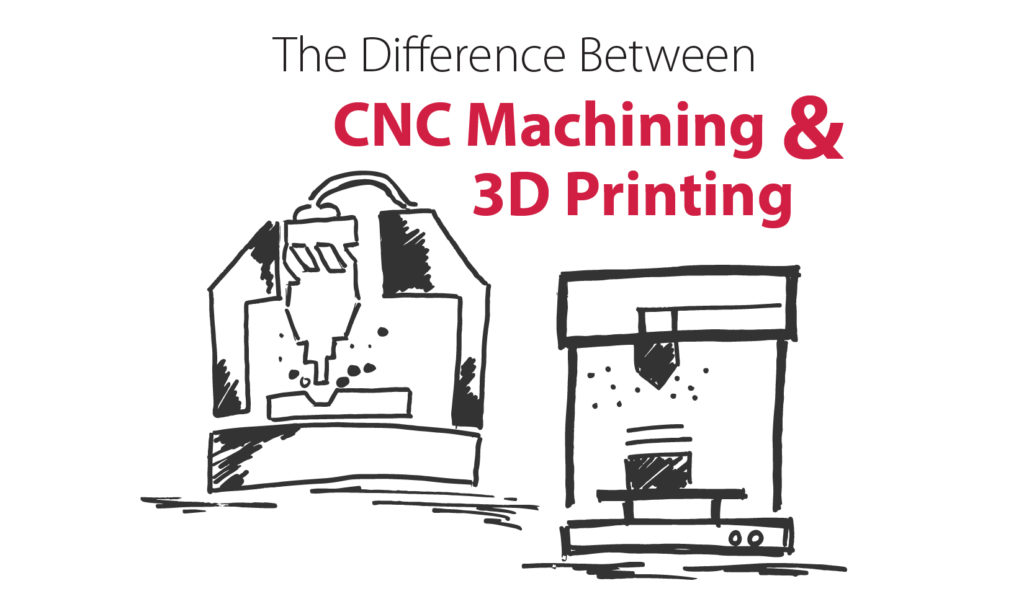
مع تقدم التكنولوجيا وإحداث ثورة في الهندسة والآلات ، فأنت تريد أن تعرف أنك تستخدم أفضل المعدات وتقود عملك إلى الأمام. بعض هذه التطورات في التصنيع الآلي للتحكم الرقمي بالكمبيوتر والطباعة ثلاثية الأبعاد. كلاهما يعمل بمواد مختلفة. ولكن أيهما أفضل لاحتياجاتك؟
هناك أوجه تشابه واختلاف بين التصنيع باستخدام الحاسب الآلي والطباعة ثلاثية الأبعاد ، ولكل منهما مزايا فريدة. لديهم ظروف مختلفة حيث قد ترغب في استخدامها فيما يتعلق بالتكلفة والتوافر. سيساعدك تقسيم كل أسلوب تصنيع على اختيار أفضل طريقة تناسبك أنت وعملك.
تحدث الاختلافات الرئيسية في إنتاج ، النفايات ، على نطاق و ، توفر المواد و حجم الأجزاء.
أوجه التشابه بين التصنيع باستخدام الحاسب الآلي والتصنيع الإضافي (الطباعة ثلاثية الأبعاد)
يعتبر كل من التصنيع باستخدام الحاسب الآلي والتصنيع الإضافي من الحلول التي يتم التحكم فيها بواسطة الكمبيوتر لصنع المنتجات من مادة معينة. كلا الجهازين في طليعة بناء التكنولوجيا بأمان وكفاءة.
As machinists and engineers want to build a prototype, a part or a custom product, they can turn to one of these machines to do the job for them. As long as the machines have the design, you don’t have to worry about human error because the machines are automated. While this doesn’t mean issues don’t arise, there’s more consistency with production and less chance of injury.
There is some overlap with these two manufacturing methods. Some CNC machines can use STL and OBJ files, which 3D printers also accept.
تعد ماكينات CNC أقدم من الطباعة ثلاثية الأبعاد ولا يزال لها موطئ قدم أقوى في التصنيع. بدأ النموذج في الأربعينيات من القرن الماضي وتم تشكيله ليلائم الصناعة حتى الوقت الحاضر. ظهرت الطباعة ثلاثية الأبعاد في عام 1986. ما زالت جديدة نسبيًا وتتطور لتصبح أكثر سهولة ومتعددة الاستخدامات. يمكن أن تساعد الطباعة ثلاثية الأبعاد في بعض مجالات النماذج الأولية ، ولكنها ليست أداة بديلة لتصنيع CNC.
إنهما ليسا بدائل عن الآخر بقدر ما هما جانبان من جوانب عالم التصنيع. إنهم يلبيون مطالب مختلفة ويتعاملون مع مواد وأسواق مختلفة. تتمتع كل من آلات CNC والطباعة ثلاثية الأبعاد بقدرات وقيود فريدة تناسبها لوظائف محددة. نظرًا لأنهم يناسبون مجالاتهم في السوق ، فأنت تريد مقارنتها بأي مجال أنت فيه.
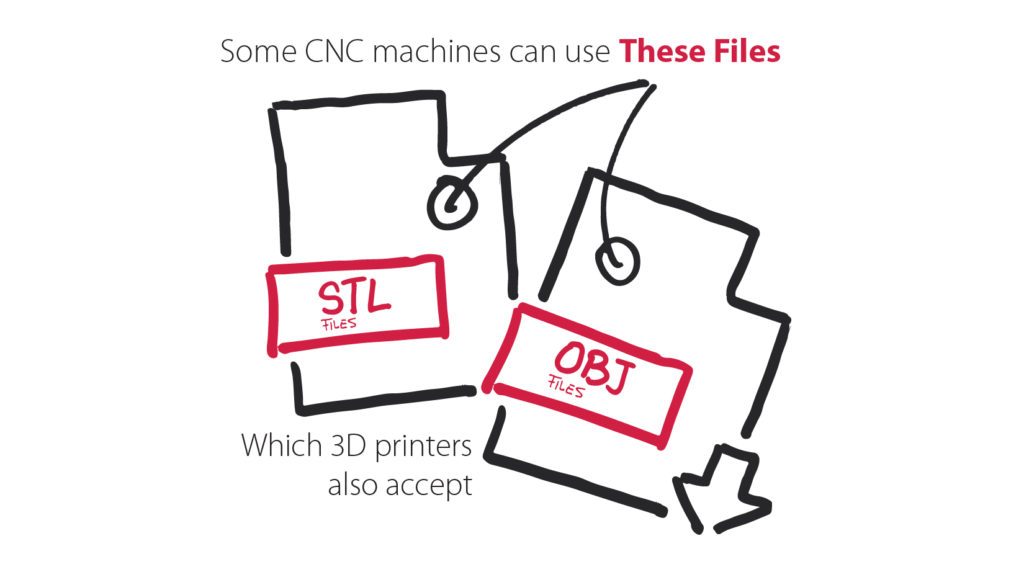
الاختلافات بين الآلات باستخدام الحاسب الآلي والطباعة ثلاثية الأبعاد
From their building methods to what applications they can handle, CNC machining and 3D printing offer creative solutions in vastly different ways. Finding out their differences and strengths will help you find which one is right for you and your business.
3D printers are typically more efficient than traditional manufacturing. The printer uses the materials that make up the item it’s creating, whereas traditional manufacturing methods such as CNC Machining require more materials for the mold to work. On average, 3D printers produce less waste than traditional manufacturing methods.
However, when production is large-scale, traditional manufacturing methods have a distinct advantage. Assembly lines are faster than a 3D printer in mass production because printers build layer by layer. In the hours that it could take to 3D print a product, an assembly line could have mass-produced hundreds of the same product.
Additionally, 3D printers can only use the area of the printing bed for making parts. Large-scale parts might not fit in that space. While the parts can be broken down into smaller pieces 3D printers can build, that might not be cost-effective and will take time. Traditional manufacturing has the advantage of the assembly line’s labor and will be able to produce items on a larger scale. Future 3D printers could be able to build larger items, but not on the level of what CNC machines offer with regard to quality and quantity.
3D printers can manipulate different materials such as plastics, metals and polymers. However:
- Not all 3D printers can use these materials. It takes separate machines for each material.
- 3D printers cannot work with every material that traditional manufacturers use due to high melting points.
- Some projects might not be able to consider using 3D printers if they require specific materials that are incompatible with the printers.
Here is the bottom line — 3D printing won’t replace traditional manufacturing because of its disadvantages in mass-produced items.
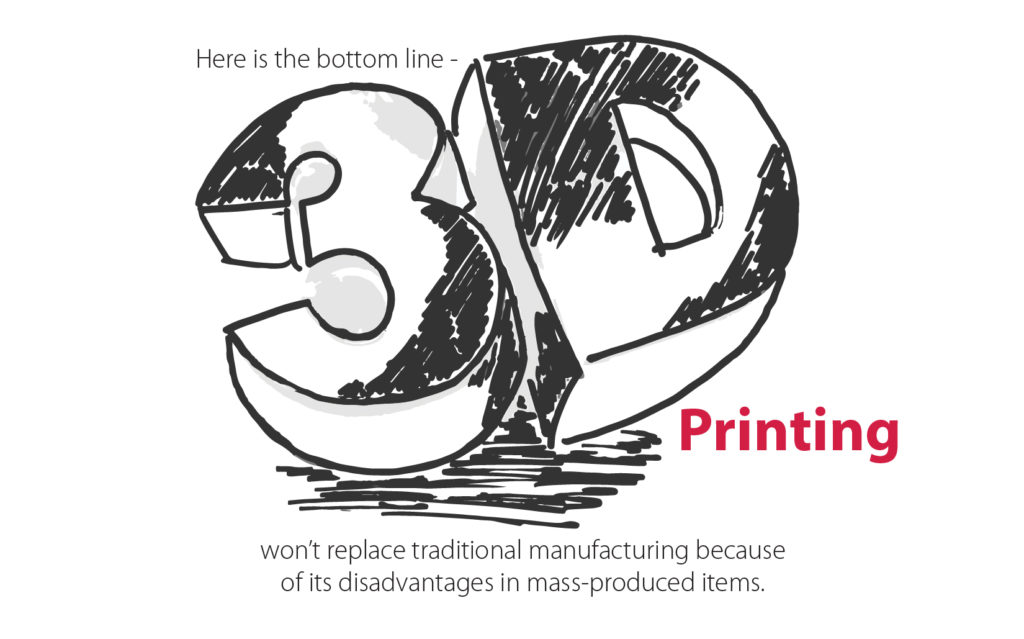
3D Printing vs. Traditional Manufacturing
CNC machining starts with a block of material and shapes it with a rotating tool. Following the program, it carves away excess until you have the finished product. This is the subtractive method because it’s taking away material.
3D printing layers on material in the additive method that builds your design. Both ways have pros and cons in terms of durability, precision and use of materials.
Material Usage for CNC and 3D
CNC machining works with a variety of materials. They can use:
- Metal alloys
- Woods
- Acrylic
- Modeling foam
- البلاستيكية الحرارية
- Machining wax
CNC machines have heating systems that can manage heavy materials. These materials are used to build substantial parts for engines, aircraft and other machines. They need to be exact, dependable and durable. The cutting tools for the design might have to switch, but most tools are standardized to fit any CNC machine.
3D printing doesn’t have this variety, using materials like plastics or resins. They can’t produce items strong enough to withstand intense environments like airplanes or other machinery. Also, 3D printers can’t switch between materials. Certain 3D printers are for specific kinds of material.
3D and CNC Precision of Production
CNC machining is more precise and consistent than 3D printing because they have a higher tolerance for heat. 3D printers end up with distorted products when there’s too much heat. They can offer precision but cannot remain consistent. 3D printers are often regarded as more user-friendly than CNC machines, but when they malfunction, someone has to troubleshoot them because the fault means production of unusable products.
CNC and 3D Speed of Production
CNC is a faster solution than 3D printing. Automated CNC machines can work around the clock as long as they’re properly maintained. A project that could take CNC machining an hour would equate to a 3D printer taking hours to get the final product because it has to build the product layer by layer. A 3D printer’s pace might have to slow down during the process to get the design right. Different 3D printers could also be programmed with specific speeds that you can’t alter. It depends on the machine you use.
3D printed products also require work after they’re built. The products need to be washed, polished and sealed before people can use the product. This could extend prototype testing to a longer time period with a lot of waiting in between. 3D printers are also popular for smaller, custom-manufactured items. But if you have to wait for the item to be built and still do a lot of work post-print, you lose a lot of time before you can move the product.
Versatility of Machinery for CNC vs. 3D
CNC machines can produce fixtures, tools and custom-designed parts. They have a wide range of quality settings so you can make a prototype that has a rougher design in some areas and perfect in others so you can test that part.
When testing prototypes for a project, a CNC machine could quickly build a design so the developers can test it. 3D printers don’t have these kinds of options. It will slowly shape the design as it was programmed. Accuracy is key when constructing a final product, but when time is a constraint and you want to test some prototypes, 3D printers can slow down you and your project. Designs made for a CNC machine usually can’t be substituted with a 3D printer because the products are voluminous and it would take hours for a 3D printer to finish them.
Noise and Mess Produced by CNC and 3D
هذه الاختلافات تتعلق بالطرق الطرح والجمع. تعد المعالجة باستخدام الحاسب الآلي أكثر ضوضاء وفوضى من الطباعة ثلاثية الأبعاد لأنها تستخدم أداة لقطع المواد. ينتج عن ذلك ضوضاء والكثير من نفايات المعادن أو نشارة الخشب. تسبب آلات CNC الكثير من الاهتزازات ، لذلك يجب أن تكون في مكان لا يزعج فيه أي شخص. تستخدم الطباعة ثلاثية الأبعاد فقط المواد التي تحتاجها للمنتج. لا يوجد نفايات قليلة أو معدومة ، ولا تهتز الطابعات مثل آلة CNC.
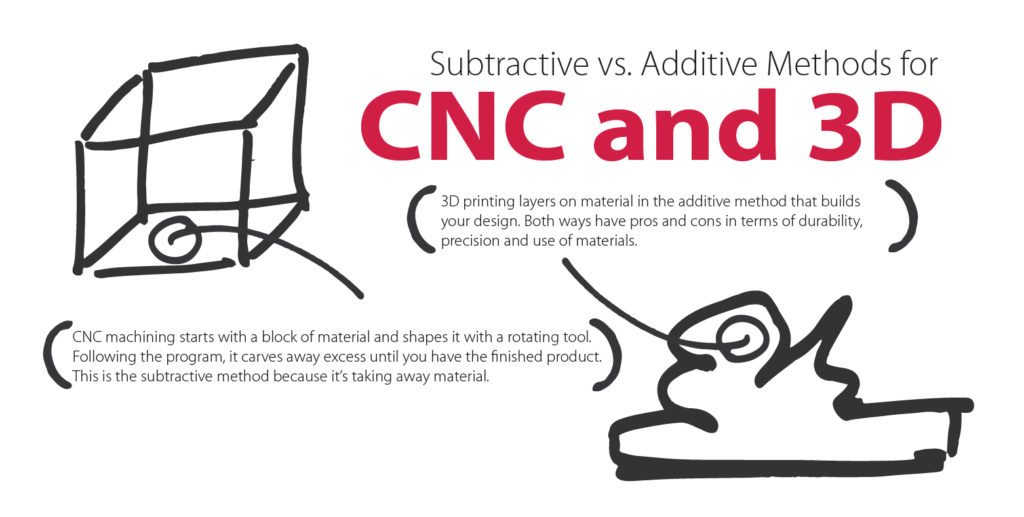
تطبيقات CNC و 3D
يمكن لآلات CNC تصنيع منتجات أكبر ويمكنها التعامل مع مقاومة الحرارة تحتوي الطباعة ثلاثية الأبعاد على المزيد من الفئات المتخصصة ، مثل طباعة الطعام أو العمل في الفضاء.
التصنيع باستخدام الحاسب الآلي مقابل الطباعة ثلاثية الأبعاد
According to World Finance, 3D printing is not a solution that can replace CNC machining. 3D printing is a part of the manufacturing world, but it’s not the invention that’s going to change the market as everyone knows it.
3D printers can improve certain aspects of manufacturing but cannot handle the whole market, as CNC machining still works better in many situations. CNC machining still offers better quality than expensive 3D printers.
On a smaller production scale, 3D printers have an edge in saving businesses money from buying expensive molds. They also offer an insight to the product’s shape and aesthetic. But as production increases and time factors in, they don’t hold up as well as CNC machines.
BENEFITS OF CNC MACHINING OVER 3D PRINTING
CNC machining fits with mass production. It can create many products in a shorter period, where 3D printing would take hours to create one product. That’s just one advantage of CNC. Let’s take a look at some others.
Prototyping Becomes Easier
CNC machines are better for prototypes that can withstand structural tests because they carve the design from the material. They can also build prototypes out of the exact material that will be used to make the final product.
Structural tests and alterations will be more accurate because they use the same material. This could speed up the production process because the changes will be to the design and not the material. 3D printers don’t fabricate prototypes with the structural strength, so they can’t conduct physical tests.
Prototype Integrity Improves
CNC machines don’t heat the material and reform it. The material stays stronger and has a better structural integrity than 3D printers, which have to heat the material to build the intended product. 3D printers might also have to add foreign materials to the mixture to be able to make the prototype, which CNC machines don’t need.
Surface Finish Advantage
CNC machines provide better surface finish than 3D printing because the materials don’t deform during the process. The rigid material and cutting action keeps the product together and has fewer chances for mistakes or deformations to occur. 3D printing has poorer surface finish. The material bends, warps or distorts because the material is layered heated plastic.
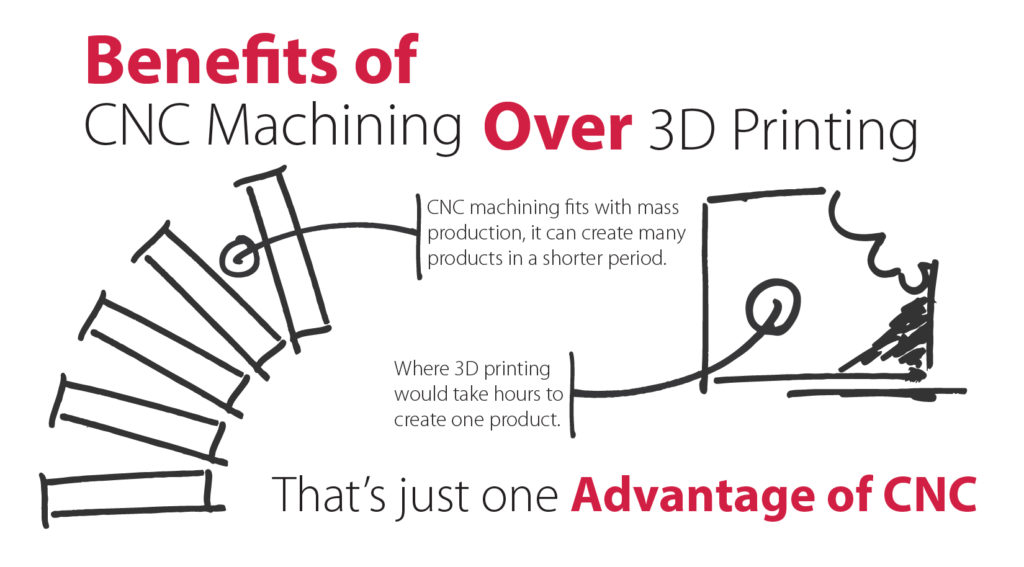
Tolerance Levels Rise
تعمل آلات CNC بدقة أعلى ، لذلك تتمتع الأجزاء بتفاوت أفضل من الطابعات ثلاثية الأبعاد. نظرًا لمستوى التحمل ، فإن النماذج الأولية التي تحتوي على أعمدة أو متصلة بأجزاء أخرى ستكون ذات جودة أعلى وستكون مناسبة على الأرجح للمكونات الأخرى.
السعر والحجم لا يمليان السعر
تعتمد تكاليف الطباعة ثلاثية الأبعاد على حجم المواد المطلوبة. لا يحدد حجم المنتج النهائي سعر ماكينات CNC. لن تكون الطباعة ثلاثية الأبعاد فعالة من حيث التكلفة مع الطلبات الكبيرة ، وهذا هو الموقف الذي تزدهر فيه آلات CNC.
الجودة لصالح CNC
تكون الطبقات الأكبر من طابعة ثلاثية الأبعاد أسرع ولكنها ليست عالية الجودة مثل الطبقات الأصغر. إذا كنت بحاجة إلى نموذج أولي ، فلديك خيار الحصول عليه بسرعة ولكن بجودة أقل قليلاً ، أو الانتظار لفترة أطول للحصول على النموذج الأولي بأفضل جودة يمكن أن توفرها الطابعة. تمتلك آلات CNC خيارًا لك لاختيار دقة للعنصر الخاص بك. يمكنهم تقديم صفات متفاوتة في فترة زمنية قصيرة ، مما يجعلها مثالية للبناء السريع والنتائج الفورية للاختبار.
الحفاظ على انخفاض التكاليف
إذا كان لديك خيار اختيار طريقة التصنيع المراد استخدامها لمنتجك ، فإن التصنيع باستخدام الحاسب الآلي عادة ما يكون أرخص من الطباعة ثلاثية الأبعاد.
اتصل بـ Kaito mould Works، Inc. ، لتلبية احتياجاتك في التصنيع باستخدام الحاسب الآلي
يمكن أن تبني الآلات باستخدام الحاسب الآلي الأجزاء التي تحتاجها لعملك. سيقدم فنيونا الخبراء في Kaito Mould Works، Inc. عملاً متميزًا سيساعدك على تحقيق أهدافك. نهدف إلى مساعدتك في الحصول على الجزء الصحيح لمشروعك.
تقدم Kaito Mould Works، Inc. خدمات لبناء الماكينات المخصصة ، وآلة الأجزاء الدقيقة والهندسة العكسية للمكونات لتزويدك بالمنتج الذي تحتاجه على الفور. نحن نقدم حلول تصنيع CNC استثنائية للمصنعين في صناعات متعددة. إن مهارتنا في التخصص والتفاني في عملنا ستساعدك أنت وعملك على البقاء في طليعة الصناعة. لدينا الحلول التي تحتاجها. الحصول على اتصال معنا اليوم.
إذا كان بإمكاننا مساعدتك في مشروعك ، فيرجى الاتصال بنا على 0086-769-82821468 أو إرسال بريد إلكتروني إلى sales@kaitomould.com.



